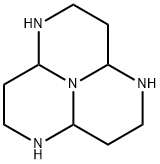N,N'-BIS(3-AMINOPROPYL)-1,3-PROPANEDIAMINE
- CAS NO.:4605-14-5
- Empirical Formula: C9H24N4
- Molecular Weight: 188.31
- MDL number: MFCD00008213
- EINECS: 225-007-8
- SAFETY DATA SHEET (SDS)
- Update Date: 2024-12-18 14:08:52

What is N,N'-BIS(3-AMINOPROPYL)-1,3-PROPANEDIAMINE?
Chemical properties
CLEAR SLIGHTLY YELLOW LIQUID
The Uses of N,N'-BIS(3-AMINOPROPYL)-1,3-PROPANEDIAMINE
N,N′-Bis(3-aminopropyl)-1,3-propanediamine (bappn) may be used in the preparation of [Ni(bappn)(ttcH)]·5H2O complex (ttch= trithiocyanurate dianion).
Definition
ChEBI: 3,3,3-tetramine is a polyazaalkane consisting of a 13-membered straight chain alkane with aza-groups at the 1-, 5-, 9- and 13-positions. It is a polyazaalkane and a tetramine. It is a conjugate base of a 3,3,3-tetraminium(4+).
Synthesis Reference(s)
Journal of the American Chemical Society, 105, p. 5002, 1983 DOI: 10.1021/ja00353a025
General Description
N,N′-Bis(3-aminopropyl)-1,3-propanediamine, a linear polyamine, has been identified in white shrimp Penaeus setiferus by gas chromatography-mass spectrometry.
Properties of N,N'-BIS(3-AMINOPROPYL)-1,3-PROPANEDIAMINE
| Boiling point: | 98-103 °C1 mm Hg(lit.) |
| Density | 0.92 g/mL at 25 °C(lit.) |
| refractive index | n |
| Flash point: | >230 °F |
| pka | 10.54±0.19(Predicted) |
| form | Liquid |
| color | Clear slightly yellow |
| Sensitive | Air Sensitive |
| CAS DataBase Reference | 4605-14-5(CAS DataBase Reference) |
| EPA Substance Registry System | 1,3-Propanediamine, N,N'-bis(3-aminopropyl)- (4605-14-5) |
Safety information for N,N'-BIS(3-AMINOPROPYL)-1,3-PROPANEDIAMINE
| Signal word | Danger |
| Pictogram(s) |
 Corrosion Corrosives GHS05 |
| GHS Hazard Statements |
H314:Skin corrosion/irritation |
| Precautionary Statement Codes |
P280:Wear protective gloves/protective clothing/eye protection/face protection. P363:Wash contaminated clothing before reuse. P303+P361+P353:IF ON SKIN (or hair): Remove/Take off Immediately all contaminated clothing. Rinse SKIN with water/shower. P305+P351+P338:IF IN EYES: Rinse cautiously with water for several minutes. Remove contact lenses, if present and easy to do. Continuerinsing. P405:Store locked up. |
Computed Descriptors for N,N'-BIS(3-AMINOPROPYL)-1,3-PROPANEDIAMINE
New Products
(S)-3-Aminobutanenitrile hydrochloride 4-Methylphenylacetic acid N-Boc-D-alaninol N-BOC-D/L-ALANINOL Tert-butyl bis(2-chloroethyl)carbamate 3-Morpholino-1-(4-nitrophenyl)-5,6-dihydropyridin- 2(1H)-one Furan-2,5-Dicarboxylic Acid Tropic acid 1-Bromo-3,5-Di-Tert-Butylbenzene S-2-CHLORO PROPIONIC ACID ETHYL ISOCYANOACETATE 2-Bromo-1,3-Bis(Dimethylamino)Trimethinium Hexafluorophosphate 4-IODO BENZOIC ACID 3-NITRO-2-METHYL ANILINE 1-(2,4-DICHLOROPHENYL) ETHANAMINE (2-Hydroxyphenyl)acetonitrile 4-Bromopyrazole 2-(Cyanocyclohexyl)acetic acid 4-methoxy-3,5-dinitropyridine 1-(4-(aminomethyl)benzyl)urea hydrochloride 2-aminopropyl benzoate hydrochloride diethyl 2-(2-((tertbutoxycarbonyl)amino) ethyl)malonate tert-butyl 4- (ureidomethyl)benzylcarbamate Ethyl-2-chloro((4-methoxyphenyl)hydrazono)acetateRelated products of tetrahydrofuran



![2-[3-CHLORO-5-(TRIFLUOROMETHYL)-2-PYRIDINYL]-N1,N3-BIS(3-MORPHOLINOPROPYL)MALONAMIDE](https://img.chemicalbook.in/StructureFile/ChemBookStructure5/GIF/CB1210705.gif)
![2-([1-(3-[[3-(DIMETHYL(3-[4-[(E)-(3-METHYL-1,3-BENZOXAZOL-3-IUM-2-YL)METHYLIDENE]-1(4H)-QUINOLINYL]PROPYL)AMMONIO)PROPYL](DIMETHYL)AMMONIO]PROPYL)-4(1H)-QUINOLINYLIDENE]METHYL)-3-METHYL-1,3-BENZOXAZOL-3-IUM TETRAIODIDE](https://img.chemicalbook.in/CAS/GIF/143413-85-8.gif)



You may like
-
 2033-24-1 98%View Details
2033-24-1 98%View Details
2033-24-1 -
 42831-50-5 5-METHYLISOXAZOLE-4-CARBOXYLIC ACID 98%View Details
42831-50-5 5-METHYLISOXAZOLE-4-CARBOXYLIC ACID 98%View Details
42831-50-5 -
 1975-50-4 98%View Details
1975-50-4 98%View Details
1975-50-4 -
 2-HYDROXY BENZYL ALCOHOL 98%View Details
2-HYDROXY BENZYL ALCOHOL 98%View Details
90-01-7 -
 2-Chloro-1,3-Bis(Dimethylamino)Trimethinium Hexafluorophosphate 221615-75-4 98%View Details
2-Chloro-1,3-Bis(Dimethylamino)Trimethinium Hexafluorophosphate 221615-75-4 98%View Details
221615-75-4 -
 61397-56-6 CIS BROMO BENZOATE 98%View Details
61397-56-6 CIS BROMO BENZOATE 98%View Details
61397-56-6 -
 14714-50-2 (2-Hydroxyphenyl)acetonitrile 98+View Details
14714-50-2 (2-Hydroxyphenyl)acetonitrile 98+View Details
14714-50-2 -
 118753-70-1 98+View Details
118753-70-1 98+View Details
118753-70-1
Statement: All products displayed on this website are only used for non medical purposes such as industrial applications or scientific research, and cannot be used for clinical diagnosis or treatment of humans or animals. They are not medicinal or edible.